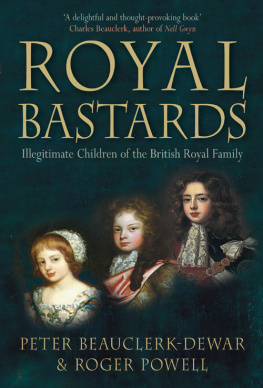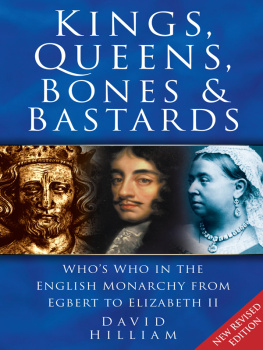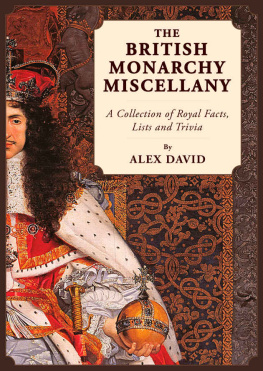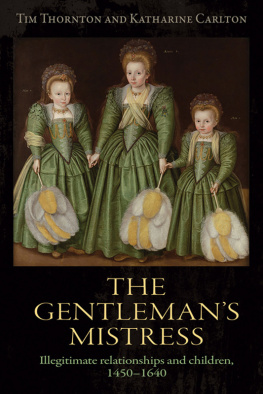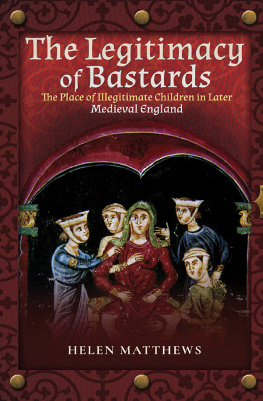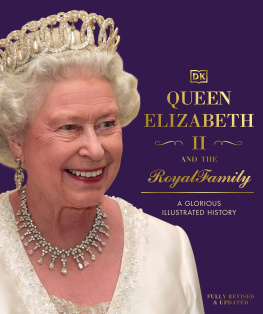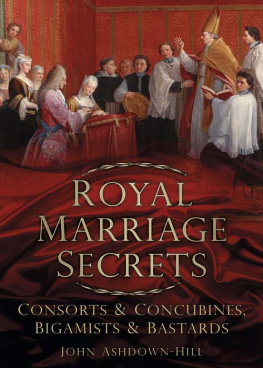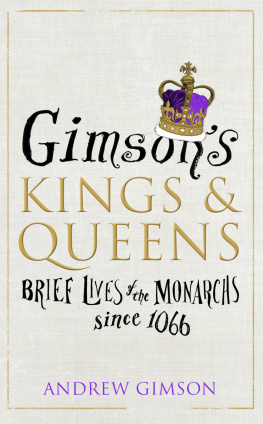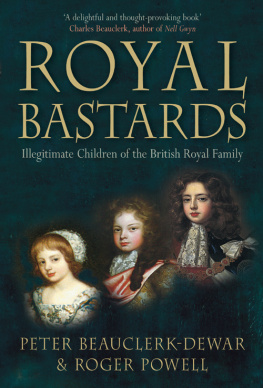ROYAL
BASTARDS
About the Authors
Peter Beauclerk-Dewar is a direct decendent of the bastard offspring of Charles II and Nell Gwyn. He is a heraldic consultant to Christies, has previously been an editor for Burkes Peerage & Gentry, and is a fellow of the Scottish Society of Antiquaries. He also a JP and a trustee of the Institute of Heraldic & Genealogical Studies at the University of Kent. He lives in London.
Roger Powell has been a professional genealogist for over 40 years. He was until his recent retirement a senior editor at Burkes Peerage and Gentry and Director of Debretts Ancestory Research. He was also a research assistant at the Royal College of Heralds. He is also related to the Duke of Monmouth, another bastard son of Charles II. He lives in Northamptonshire.
ROYAL
BASTARDS
Illegitimate childern of the British Family
PETER BEAUCLERK-DEWAR
& ROGER POWELL

This edition first published 2008
The History Press
The Mill, Brimscombe Port
Stroud, Gloucestershire, GL5 2QG
www.thehistorypress.co.uk
This ebook edition first published in 2012
All rights reserved
Peter Beauclerk-Dewar and Roger Powell, 2006, 2008, 2012
The right of Peter Beauclerk-Dewar and Roger Powell, to be identified as the Author of this work has been asserted in accordance with the Copyrights, Designs and Patents Act 1988.
This ebook is copyright material and must not be copied, reproduced, transferred, distributed, leased, licensed or publicly performed or used in any way except as specifically permitted in writing by the publishers, as allowed under the terms and conditions under which it was purchased or as strictly permitted by applicable copyright law. Any unauthorised distribution or use of this text may be a direct infringement of the authors and publishers rights, and those responsible may be liable in law accordingly.
EPUB ISBN 978 0 7524 7316 1
MOBI ISBN 978 0 7524 7315 4
Original typesetting by The History Press
Contents
Foreword
By HRH The Duke of Gloucester, KG, GCVO
Monarchy is by definition a family affair. The principle of heredity prevents conflict in the selection process. Illegitimacy confuses this event and causes uncertainty as occurred in the case of Edward V disqualified by his uncle Richard III.
Monarchs and their families are governed by the same laws of physics and biology as everyone else, but what sets them apart is the notice taken of what they do and what they might do next.
This intense and prolonged scrutiny can be clouded by the human desire to be in the know and not to be thought unaware of what is happening. For this reason royal gossip and speculation has always been magnified compared to other gossip. In the distant past bastard children were acknowledged and promoted as an extension of royal power. Queen Victoria, influenced by Prince Albert was determined to change this attitude, leading, some would say, to a more hypocritical age.
It is easy to disapprove of the reckless way that Charles II shamed his barren wife by producing so many illegitimate children by so many different mothers. However it is difficult to regret it if you discover, as I did, that you are descended from several of them!
It was George III, who against all advice, insisted on the passing of the Royal Marriage Act, to give him greater control of his dynasty, and its potential for marriages of foreign policy advantage. He created the successions crisis of 1817, when Princess Charlotte died and in spite of having 14 children there was no eligible grand child to take the throne, for all his male children had chosen brides for themselves and married morganatically. The Duke of Kent rose to the challenge and produced Queen Victoria in time to solve the problem.
Bastard has come to be a term of abuse, as if anyone, who suffered the uncertainties of illegitimacy, was bound to have warped their morals and behaviour.
Peter Beauclerk-Dewar and Roger S. Powell have covered five centuries of alleged bastards, including those acknowledged by the father, as well as those merely speculated, and tried to examine the claims and counter claims dispassionately. Some were ignored by their putative fathers, others supported openly or discretely. If all of them were touched by a sense of importance and destiny, I would like to believe it would encourage them to feel that they should contribute to the nations good rather than claim its benefits for themselves.
Introduction To First Edition
The word bastard, described by the Oxford Dictionary as one begotten and born out of wedlock, is no longer fashionable, now that nearly fifty per cent of all children in this country are born outside marriage. Moreover, it is claimed that the true fathers of many supposedly legitimate children are not in fact so, even though it has always probably been thus, for it is said that it is indeed a wise man who knows his own father. However, the advent of DNA has certainly injected rather more certainty into identifying paternity with all the embarrassments that this might cause.
As part of the research for this book, we have been able to identify the genetic y chromosome of the Stuart Kings which is, of course, unique to the male line.
We have been able to do this by identifying the same y chromosome in the DNA samples provided by four quite separate lines of male descendants of Stuart kings. This will now provide a benchmark against which other claimants can be measured, for all male line descendants of Stuart kings should all have this unique y chromosome. But what it does do is to scotch, once and for all, the assertion that Colonel Robert Sidney was the father of the Duke of Monmouth, rather than King Charles II, as some had claimed.
Until recently, Burkes Peerage & Baronetage and Burkes Landed Gentry always drew a veil over illegitimacy and it is only in recent years that natural children have been included, other than, of course, those Royal Bastards who were ennobled and thus qualified for inclusion on those grounds.
Nevertheless the stigma attached to bastardy has always seemed rather unfair whereby the child is blamed for the sins of its parents. Yet in previous generations the stigma was all too real and the accident of birth could have far reaching effects upon the child as the laws of inheritance and succession to titles, names, estates and arms often precluded bastards. Yet conversely in the case of Royal Bastards, they were often given special titles, privileges and positions and the possibility of really lucrative marriage contracts, as we shall see.
It is amusing to find that, even today, the Royal Archives Security scanning system rejected our e-mail attachment of this text because it violates our acceptable use policy on profanity following inclusion of the word bastard in the title of the book.
Cecil Humphery Smith, the Principal and Founder of the Institute of Heraldic and Genealogical Studies in Canterbury, considers attitudes towards bastards in his thought-provoking article (see page 259). In 1979 he published a number of articles in The Coat of Arms entitled The armorial bearings of the illegitimate issue of the Kings of England and he has now consolidated and expanded these thoughts into an article (see page 270). Indeed, we acknowledge his contribution towards the heraldry contained in this volume.
Moreover, in keeping with changing public attitudes, the law relating to illegitimacy has also changed over the years, and from 1926 in England, those parents who subsequently marry, thereby legitimate any children they may have had beforehand, provided that they had been free to marry at the time of their childs birth. Under the

